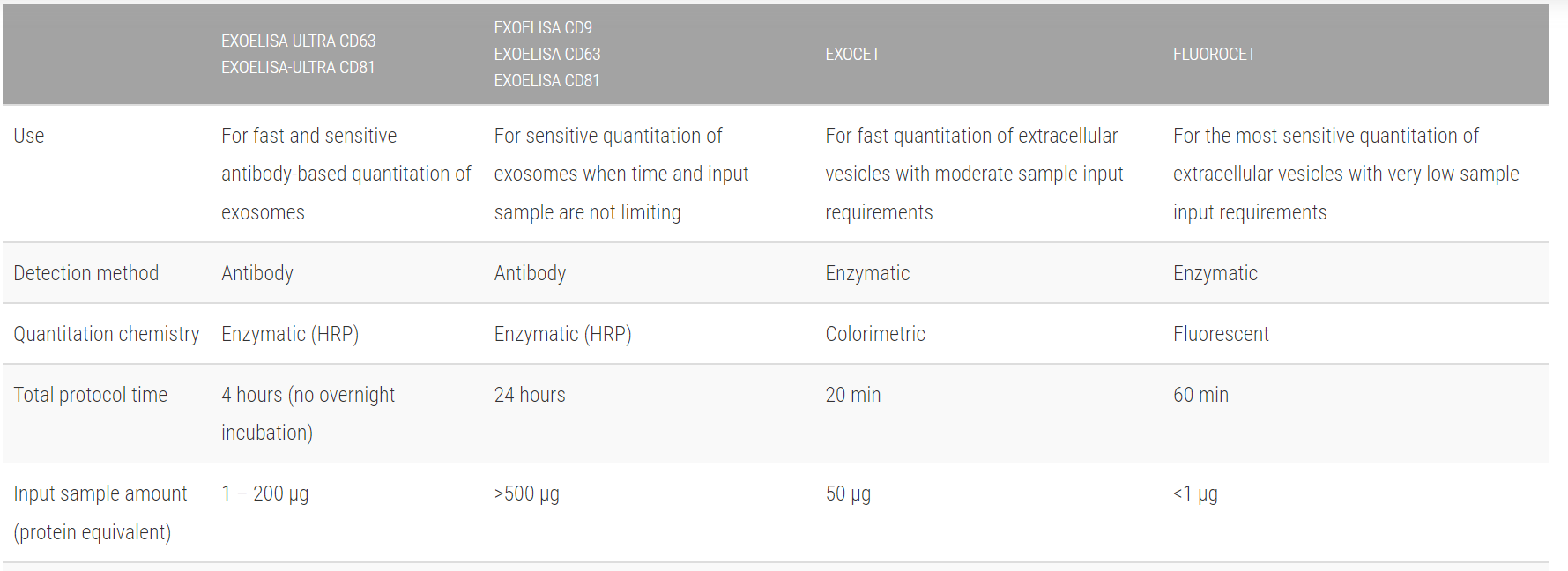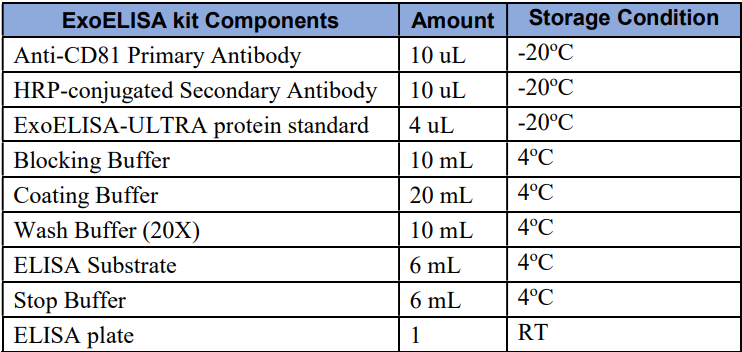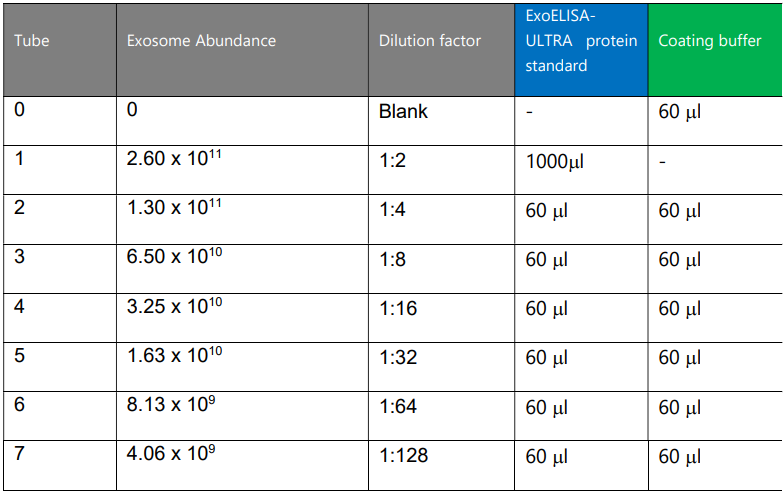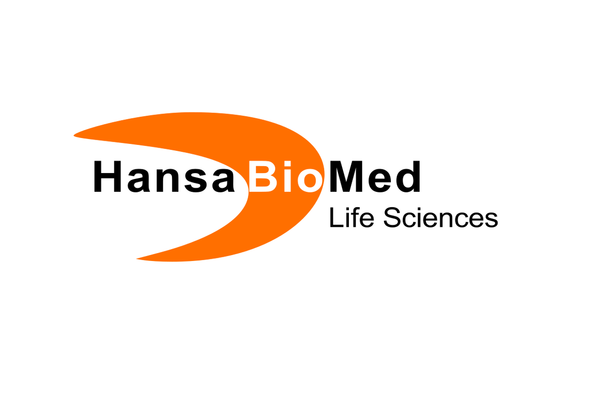Description
- Sensitive—detect as little as 1 µg protein equivalent
- Fast—complete in less than 4-hours—no more overnight incubation
- Flexible—compatible with all major exosome isolation methods (e.g. ExoQuick, ultracentrifugation, ultrafiltration, and immunoaffinity capture) from human samples
- Quantitative—calibrated internal standards enable quantitation of exosomes carrying CD81
- Sample-saving—requires significantly less sample than our standard ExoELISA Kit, leaving more for other downstream applications
Delivering ELISA-based exosome quantitation ULTRA fast
Improving on our popular ExoELISA Kits, the ExoELISA-ULTRA CD81 Kit increases the sensitivity of exosome detection—as low as 1 µg protein equivalent—while shortening the total assay time to only 4 hours.
Currently configured for detection of CD81, a common exosomal marker, ExoELISA-ULTRA CD81 is based on an ultra-sensitive, direct capture, colorimetric ELISA assay that is compatible with common biofluids. The ExoELISA-ULTRA CD81 Kit comes with an internal standard calibrated to exosomes from a range of biofluids. Calibration is achieved by NTA analysis and enables quantitation of exosomes carrying CD81 in your target samples. One ExoELISA-ULTRA CD81 Kit contains all of the necessary reagents (including assay plate) to perform up to 96 reactions.
Choose the exosome quantitation method that’s best for your studies

The ExoELISA-ULTRA CD81 assay is a sensitive, direct Enzyme-Linked ImmunoSorbent Assay (ELISA) to quantitate exosome abundance in a given sample that can be performed within 4 hours, start to finish. Exosomes are captured intact on the high protein binding microtiter plate. The wells are incubated with an anti-CD81 primary antibody which recognizes the tetraspanin protein on the exosomal surface. A Horseradish Peroxidase enzyme linked secondary antibody is used for signal amplification. A colorimetric substrate (extra-sensitive TMB) is used for the assay read-out. The accumulation of the colored product is proportional to the amount of specific CD81 antigen present in each well. The results are quantitated by a microtiter plate reader at 450 nm absorbance.
List of Components

Storage
The kits are shipped at blue ice. Individual kit components are stored at different temperatures. Please review the kit component list carefully. Properly stored kits are stable for 6 months from the date received.
Equipment to be supplied by user
1. Microtiter plate sealing film/cover
2. 37°C incubator
3. Microtiter plate shaker
4. Microtiter plate spectrophotometer with 450 nm absorbance capability
5. Multichannel pipets (recommended)
Protocol:
Exosome Precipitation
For simple and quick isolation of exosomes from serum, we recommend using the ExoQuick precipitation solution (Catalog# EXOQ5A-1 or EXOQ20A-1) and the ExoQuick-TC/CG for isolation of exosomes from tissue culture media and urine samples (EXOTC10A-1 or EXOTC50A-1) using the recommend protocols. Resuspend the pellet in sterile DPBS.
Sample Preparation
The recommended input of protein equivalent of exosomes will vary depending on the biofluid and exosome isolation method. For ExoQuick and ExoQuick-TC isolation, we recommend using 1-200ug of protein input/well for
the ExoELISA-ULTRA assay.
1. Use an input of 1-200ug protein equivalent of exosomes/well. The assay signal strength is dependent on the expression level of CD63 on the exosome membrane. We recommend the use of 25ug of protein as a
good starting point for the assay.
2. Make up the volume of exosomes (resuspended in sterile DPBS) to 120uL with the Coating Buffer (sufficient for duplicate wells).
Exosome Protein Standard Curve
A standard curve should be prepared each time the assay is performed. DO NOT freeze-thaw diluted standards.
Make a fresh dilution of the standards (see Step 2, below) each time the assay is performed.
1. Thaw ExoELISA-ULTRA protein standard on ice
2. Dilute ExoELISA-ULTRA protein standard 1:1000 in Coating Buffer in a microcentrifuge tube first (for example, add 1uL Standard to 1mL Coating Buffer). Vortex to mix well. Use this dilution as the First Standard
for the standard curve.
3. Perform serial dilutions of the First Standard in Coating Buffer in microcentrifuge tubes. Vortex to mix well after each dilution.
4. Suggested dilutions for making the ExoELISA-ULTRA standard curve are shown below. To run the standards in duplicate, double the recipes listed and split into two separate wells.
5. Discard the diluted standards after use, do not freeze-thaw or reuse any of the diluted standards.
Suggested Dilutions – Standard Curve







